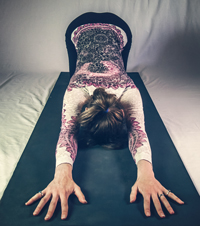by Kara-Leah Grant
There are days when I spend too much time commuting, too much time on my computer, and have far too many balls in the air.
My mind feels like it’s going a million miles a minute, flitting first from one thing, then to the next.
Sometimes this monkey mind is shadowed by anxiety or fear, lurking deep in the belly and driving me out of my body and up into my head.
It’s exhausting.
And on days like that, I know exactly what kind of yoga I need to do – yoga to still the mind.
It’s simple. It’s slow. It’s breath-led – always breath-led. First I breath, and then I move. If I ever lose track of my breathing, I’m moving too fast and I’m not being mindful enough.
On days like this, fast power yoga doesn’t cut the mustard – the physical nature of the practice becomes a distraction and I can often end up feeling more ungrounded and spaced out than when I began.
Partly this is because my over-active mind is fuelled by crazy energy and a strong asana practice – while it can be grounding with lots of standing postures and strength – just amps my energy even more.
So I keep it slow.
And I listen to my breath.
I usually started with some kind of simple pranayama – two of my favourite involve breath with arm movements.
One is designed to bring energy into my body – kinda like collecting all the loose flying, flitty bits of mind way out there in my own personal mind-stratsophere and call them home again to home base.
The other is about re-kindling my relationship to the earth and solidifying the air between me and the ground.
Both, when done slowly and mindfully at a breaths-pace, have a calming and nurturing affect on my mind.
After that, I move into slow, breath-led asana.
The purpose of this asana is little more than freeing my spine, liberating my pelvis, and bringing energy into all my limbs.
You’ll be surprised how few and how simple these asana need to be. It’s the quality of attention and mindfulness that’s brought to the asana that makes them powerful.
I usually start in Tadasana, and I’ve been known to stand there for ten minutes feeling into every aspect of my body, breathing into every single cell of my body – except the ones that haven’t yet come alive.
You think Scorpion’s a tough pose? Try ten minutes of Tadasana with unwavering focus.
Of course, standing in Tadasana might be great for starting the process of bringing me back into my body, but it takes more than that to loosen and unwind tension and still the mind.
So from there I move into endless variations of standing forward bends, depending on where my body is feeling it today.
Tight hamstrings? Tight upper back? Sore lower back? Strained neck? Doesn’t matter. I move slowly and let my breath lead… fancy that eh? Yes, I trust that my breath can take me into the perfect Uttanasana for today.
After all that forward bending, it’s time to counterpose, and I choose a posture that serves dual purpose. It both allows me to release my lower back and my hamstrings, and it is calming and soothing on the mind – half downward dog. It’s one of the most under-rated postures of all time. It does beautiful things for my pelvis, for my spine, for my upper back, my shoulders and my belly. And, as I’ve already mentioned, because I’m resting my forehead on the ground, it’s soothing for my over-active mind.
Bliss, right there, thank you half-downward dog!
If you’re still with me, you may have noticed that so far I’ve done some pranayama and three postures.
Guess how long I’ve spent on the mat? Anywhere from five minutes to 30 minutes. Easily. And that’s the beauty of this kind of practice, it’s like an accordion – it extends and contracts to suit whatever time frame you’ve got, and you can choose which postures to spend more time depending on what’s happening in your body.
That’s also the beauty of home yoga practice – it’s can evolve to suit your needs perfectly.
After half-downward dog, I get back into some serious spine opening and play with variations of Cat’s Breath and Dancing Cat.
I move slow, I move fast, I wiggle, I shake, I breathe into every vertebrae and see if I can discern exactly what’s going on with my spine – where’s it’s shut down, where it’s blocked, where it needs some energy.
After all that moving and breathing and shaking it, I need to come back to stillness and tune into my breath again. So I choose a small, still postures.
Maybe Child’s pose. Often Virasana. There’s something wonderful about sitting on one’s heels and feeling into the body. I can sense how my mind has shifted and settled since starting my practice, and I can discern where I need to go next.
It may be, at this stage, I do decide to do a stronger asana practice, and move into sun salutations or variations there of… or I continue with my slow, mindful practice to still the mind.
The perfect posture for this stilling the mind? Sukhasana with a forward bend.
I love this. It’s been a god-send over the last few years, and with much patience and slow breathing, it’s opened my hips, pelvis and spine up in the most delicious ways.
Again, there are many variations you can explore, depending on the flexibility of your body. You can even get a chair in on the act, and give your forehead something to rest on if you’re not able to melt forward far enough yet to contemplate putting your forehead on a block or the ground.
Playing in Sukhasana (Easy Pose), alternating legs, taking time, can take me anywhere from four minutes to 30 minutes. By the time I’m done, I’m calm and ready for Savasana.
But just in case my mind still hasn’t totally settled, I always take time for nine rounds of Alternate Nostril Breathing to complete my practice.
Regardless, by the end of this practice, my mind has gone from wind-whipped to deeply calm.
And that I love.
Thank you yoga, for stilling my mind.


[…] How to Calm an Overactive Mind with Yoga […]